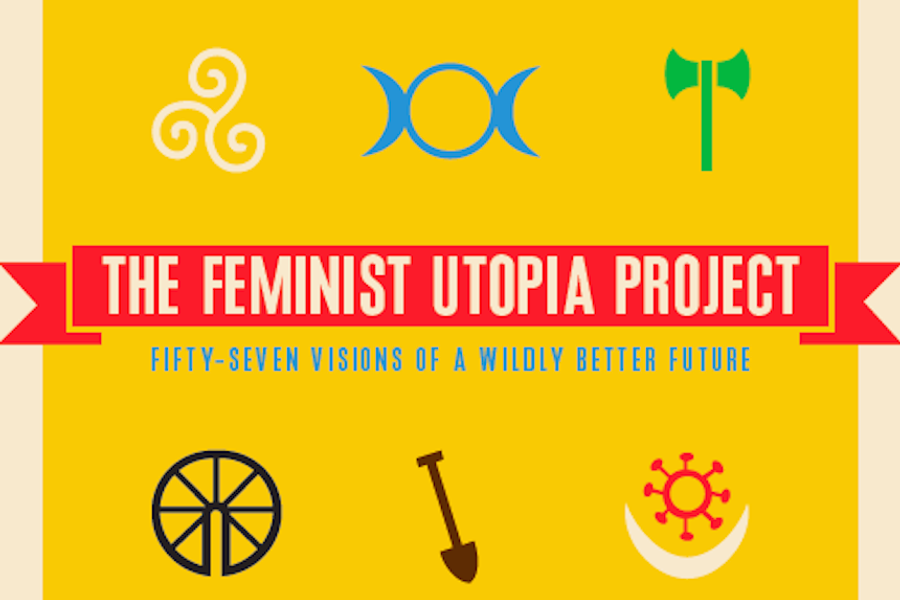The Feminist Utopia Project Isn’t Utopian Just Yet
What’s missing? Age diversity and an economic analysis.
Yasmin Nair

The Feminist Utopia Project: Fifty-Seven Visions of a Wildly Better Future (Feminist Press) is a collection of 57 short essays and interviews with a self-explanatory title: It aims to convey what utopia might look in a feminist world. Or, at least what utopia looks like to some kinds of feminists, and what some kinds of feminism look like in some utopias. Notably missing are discussions of capitalism and visions of utopias for women over 40.
Children and reproductions are prominent themes here. Kate Riley asks, “What Will Children Play with in Utopia,” and the answer, illustrated by Richard Espinosa, is … dough, wet sand, mud, and bubble wrap, all given to children in lieu of Ipads and software and meant to encourage them to move through the world guided by their senses. Essays by Justine Wu, Jenny Trout, and Gloria Malone imagine a world that provides abortion access, long maternity leave, and childcare for teen parents. Sovereign Syre and Melissa Gira Grant address the stigma surrounding sex and sex work, especially in feminist circles.
But capitalism plays a more obscure role. Of course, in addressing matters of sex, reproduction, and childcare and the workplace, writers are invariably addressing capitalism, even without naming it. But when they do, it’s in curious ways. In Sheila Bapat’s “Imperfectly: A Feminist Utopian Economy That Embraces and Addresses Human Flaws,” she writes that domestic labor should be compensated. However, “a feminist utopian economy would not, necessarily, be an anticapitalist one.” The “necessarily” provides something of a caveat, but the statement is still a startling one. It is, after all, capitalism that mandates the exploitation of labor, and it is capitalism’s logic of supply and demand (rather than worth to society or workers’ rights) that devalues domestic labor: how are we to get to valuing labor without an anti-capitalist agenda?
Bapat’s piece places a strong emphasis on curtailing greed, arguing for a feminism that instead “involves acknowledgment that humans are flawed, ever-changing, needing love, needing validation, and always moving in directions that earn them love and validation.” She writes about the need to “ensure greed never overruns decent conditions for workers.”
The problem here is that greed is situated as an emotional and cultural value, rather than as what it is: a structural component of capitalism. Bapat’s plan is an emotional call that, like placing flowers in the barrels of rifles, performs little more than a symbolic function.
The Feminist Utopia Project is not meant to be a unified, cohesive manifesto but is designed to provide a sense of what utopia means for feminists in the here and now. Still, the origins and backgrounds of the editors are telling. Most are 20-somethings who write for non-paying sites such as Feministing, an ability that points to a degree of cultural and/or economic privilege. Their visions tend toward a very particular form of privileged feminism: one that emphasizes, as Bapat’s essay does, how feminists might feel in a utopia, instead of a sense of how they might bring it about. Many of the essays are concerned with emotional harmony and equilibrium. Tessa Smith in “Crazy Bitches: Redefining Mental Health (Care) in the Feminist Utopia” begins with a warning to readers to not watch the Lars Von Trier film Dogville without “loving, supportive friends.” And yet, oddly enough, her vision of utopia states that “[p]eople who are more in touch with suffering and ecstasy than the majority are not a hindrance in imagining the feminist utopia…” If this is the case, why finely calibrate people’s possible sense of hurt or even feeling of trauma in the consumption of cultural products like Dogville? Why, on the one hand, work so hard to suppress whatever emotions might arise during the watching of a movie and, on the other, claim that emotions are valid? Who gets to decide these categories of good and bad emotions?
In this and other ways, Feminist Utopia Project betrays, inevitably, the cultural landscape in which it was wrought, one dominated by trigger warnings, in which to be a feminist is less about one’s own and others’ material reality than about going through life with finely calibrated emotions, always on the lookout for the next traumatic event, always living in fear that one’s emotions might be too much.
Feminist Utopia Project, like any other utopian project, reveals as much about the past from which it has emerged as the present and the future it envisions. Today, the phrase “the personal is political” is often repeated in organizing circles, to justify the idea that talking about and taking into account people’s experiences makes for better political gains. But for feminists of the 1960s who originated the term, the phrase was a way to begin exposing the extent to which capitalism had laid waste to all parts of our lives, from the public to the private. It meant, for instance, demanding that domestic abuse be seen as a public problem and not be swept under the carpet as a “merely” private matter. All of this eventually highlighted the ways in which the privatization of the family unit serves to mask the machinations of capitalism, in the guise of unequal wage labor and the occlusion of women from the public sphere — which is about as anti-capitalist as you can get.
The feminist cultural landscape of today is saturated with the personal, but the personal has now become not much more than a pulsating sea of feelings and emotions, mostly hurt ones, with not much connection to larger anti-capitalist critiques.
As a result, Feminist Utopia Project is a curiously anti-materialist anthology. Madeleine Schwartz’s “Less Work, More Time” is the applaudable exception. She advocates for a Universal Basic Income and argues that the mainstream feminist agenda of fighting for women’s rights largely within the framework of the workplace has backfired: “Placing work at the core of a feminist demand obscures work’s problems and blinds us to life outside of it” and that, “Rather than fighting for more and better work, we should fight for more time to use as we please.”
The essays in general tend to be choppy or banal, with the plethora of emotional calls substituting for any real skill in writing. The most successful essays are those grounded in present-day realities, which take an unflinching look at the conditions that demand a radical vision of utopia — such as Melissa Gira-Grant’s piece, which points out that it’s “hard to even ask… ‘Is there sex work in our feminist utopia?’” because there is no neutral ground: “That is a ground soaked in blood before we even got here.” In this regard, one of the few well-crafted essays in the anthology is Ria Fay-Berquist’s “No Escape Hatch,” where she writes about it means to travel alone as a woman in the U.S, and the persistent sense of danger and entrapment that women are forced to feel as they navigate their way through a world where the threats of physical and sexual attack and death itself are a constant presence.
The Feminist Utopia Project is not as successful when its writers set about imagining actual utopias. One wishes to be kind because, after all, the point of a utopia is that it is a wish, a desire for something better, inherently something we cannot know but can only long for. The problem is that the vast majority of the utopias envisioned here, while racially diverse to some degree, are by people barely in their 30s — by sitting down and going through the bios of every single contributor, I was able to calculate that only perhaps 10 of them have passed 40; I suspect the vast majority of the remainder are under 30.
This has had some troubling effects on the nature of the anthology, and the first is that its hip-looking, circular Table of Contents is convoluted and difficult to navigate, especially for anyone who needs reading glasses, and the editors might want to consider that it will be as difficult for them and most of the contributors in about five years. The second effect of a collection so dominated by twenty-somethings is that The Feminist Utopia Project cannot imagine a feminist life after 30. In Medieval times, cartographers would simply place the words, “Here Be Dragons,” to indicate uncharted and consequently possibly dangerous areas of the world. In The Feminist Utopia Project, life after 30 is that dark, dangerous, uncharted territory. Over and over, older people are reduced to caretakers and near-spiritual and sexless shadows of the selves they might have been, all in the form of some kind of homage.
In “Embroidering Revolution,” Verónica Bayetti Flores (who is about a decade out of undergrad) writes fondly of someone’s abuela creating exquisite embroidered clothes that are now, in a utopian world, valued as works of art.
Dara Lind (who received her B.A. in 2009) produces a fictional narrative of a young woman arguing against citizenship ceremonies on the grounds that her grandfather needed to be able to come to America so that he could help her mother take care of her family and keep the household running.
In imagining what a feminist utopia would look like for parents of color, Victoria Law (at 39, one of the book’s older contributors) similarly imagines a world where the elderly — or, really, apparently, just people who are not over 40 — serve as caretakers for neighborhood children.
Yumi Sakugawa, who graduated college nine years ago, illustrates her vision of “Seven Rituals from the Feminist Utopia: Prebirth to Postdeath” with charming but damning images of a woman’s life. “On your 40th birthday,” she writes, “You ingest the petals of a crystal cactus flower and walk through the crystal chamber of self-knowledge.” The next set of illustrations jumps straight to age 80 because, apparently, nothing of note could possibly happen to women in the interregnum: “…you orbit your birth planet in a translucent space pod while sending prayers to all the beings below. We all look up to you.” And then, comes the end: “After your death, your ashes are used to form seed bombs which are then scattered to all corners of the galaxy.”
All of this combines to form a painfully reductive, essentialist and exploitative vision of life after 40. The truth, of course, is that your abuela may have secretly hated the hours she had to spend embroidering, and would have preferred to leave home for paid work. Your grandfather might long to travel the world but, instead, now has to spend the remainder of his life wiping bums and making dinner, subsisting on the meager allowance doled out by your parents who make it seem like it’s a privilege for him to work for them. And your neighbor down the street has better things to do with her time, like fucking her lover or organizing actions, than taking care of your children.
A feminist utopia after 30 or 40, or at least a feminist utopia that considered the needs and desires of those over 30 or 40 would look squarely at the fears and realities that include aging in a world where a broken arm won’t send you into a lifetime of bankruptcy. It would evoke a world where sex and desire are not over, rendered in sepia tones of nostalgia, but still vibrant and important parts of daily life. It would mean an anti-capitalist vision of the world which considers capitalism as an economic force, not a mode of feeling.
The Feminist Utopia Project serves as an interesting time capsule for a very particular kind of feminism; it’s important to acknowledge that and not assume that the sheer number of essays indicates much diversity of experience or vision. And there is much to be gained from its very existence — which, after all, testifies that we have not been so crushed by our present reality that we cannot bring ourselves to imagine a better future.
Yasmin Nair is a writer, academic, and activist. She’s an editor at large at Current Affairs, on the editorial board of the Anarchist Review of Books, co-founder of the radical queer editorial collective Against Equality and the (Volunteer) Policy Director of Gender JUST. She’s currently working on her book Strange Love: A History of Social Justice And Why It Needs To Die. Her writing can be found at www.yasminnair.com.








